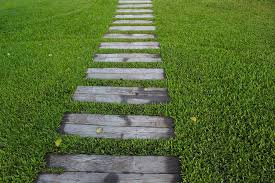
PC - Garystockbridge617
Stepping stones are a fantastic way to enhance your garden, create a charming pathway, or simply add a touch of functional beauty to your outdoor space. They can transform an ordinary garden into a stunning landscape feature. If you’re considering installing stepping stones, you’ve come to the right place. Here’s a comprehensive guide to choosing and installing them effectively.
Why Stepping Stones?
Before diving into the nuts and bolts, let’s briefly explore why stepping stones are a great choice for your garden:
- Aesthetic Appeal: Stepping stones add visual interest and a sense of structure to your garden. They can complement various garden styles, from rustic to modern.
- Functional Pathways: They create defined paths, reducing the wear and tear on your lawn and making it easier to navigate through garden beds.
- Easy Maintenance: Unlike full walkways, stepping stones require less maintenance and can be replaced individually if damaged.
- Versatility: They can be used in various ways—whether to lead from your house to the garden, across a lawn, or over a dry creek bed.
Choosing the Right Stepping Stones
Selecting the right stepping stones depends on several factors including style, material, and functionality. Here’s what to consider:
1. Material
- Concrete: Durable and customizable, concrete stepping stones can be cast in various shapes and sizes. They’re a popular choice due to their strength and ease of maintenance.
- Natural Stone: Granite, slate, and flagstone offer a natural look and can blend seamlessly with garden landscapes. They’re often more expensive but highly durable and attractive.
- Brick: Classic and durable, brick stepping stones add a traditional touch. They’re ideal for formal gardens and can be easily matched with existing brickwork.
- Recycled Materials: For an eco-friendly option, consider stepping stones made from recycled materials. These can be both sustainable and stylish.
2. Shape and Size
Stepping stones come in various shapes and sizes. The choice largely depends on your garden’s design and the function of the path:
- Round Stones: Ideal for a casual, organic look. They blend well with natural gardens.
- Square or Rectangular Stones: Best for a more formal or structured design. They work well in geometric patterns and can create a modern look.
- Irregular Stones: Perfect for a rustic or naturalistic garden. They provide a more organic feel and can adapt to uneven surfaces.
3. Color and Finish
Choose colors and finishes that complement your garden’s existing elements. Neutral colors like gray, beige, or brown tend to blend well with most landscapes. Textured or patterned finishes can add additional visual interest.
Installing Stepping Stones
Once you’ve chosen your stepping stones, it’s time to install them. Follow these steps to ensure a successful installation:
1. Plan Your Path
Decide where you want your stepping stones to go. Use a garden hose or string to outline the path and determine the placement of each stone. Consider the spacing; typically, stones are spaced 18-24 inches apart, but this can vary based on personal preference and stone size.
2. Prepare the Ground
- Mark the Area: Trace the outline of each stone with a shovel or spade.
- Excavate: Dig out the marked areas to a depth of about 2-3 inches. The depth should be sufficient to accommodate the stone and provide a stable base.
- Level and Compact: Ensure the base is level and compacted to prevent shifting. You can use a layer of sand or gravel to help with leveling and drainage.
3. Lay the Stones
- Place the Stones: Position each stone into the excavated area. Adjust as needed to ensure they’re level and spaced evenly.
- Secure the Stones: If necessary, add a small amount of sand or gravel around the edges to stabilize the stones and fill any gaps. Ensure they’re firmly in place and won’t shift.
4. Finishing Touches
- Fill Gaps: Fill any gaps between the stones with soil, gravel, or mulch. This helps to integrate the stones into the landscape and prevents tripping hazards.
- Compact the Area: Gently tamp down around the stones to ensure they’re securely set.
- Water: Lightly water the area to help settle the soil or gravel and reduce the risk of movement.
Maintenance Tips
Stepping stones are relatively low-maintenance, but a few simple practices can keep them looking great:
- Regular Cleaning: Remove debris and dirt from the stones to maintain their appearance. A mild detergent and water solution can help with tougher stains.
- Check for Shifting: Periodically check that the stones haven’t shifted or settled unevenly. Adjust as needed to prevent accidents.
- Replenish Gaps: Add more soil or gravel to gaps that may have settled over time.
Final Thoughts
Stepping stones are a wonderful addition to any garden, offering both beauty and functionality. By carefully choosing the right materials and following proper installation techniques, you can create a charming and durable pathway that enhances your outdoor space. With a little planning and effort, your stepping stones will provide a picturesque and practical solution for navigating your garden for years to come. Happy gardening!





